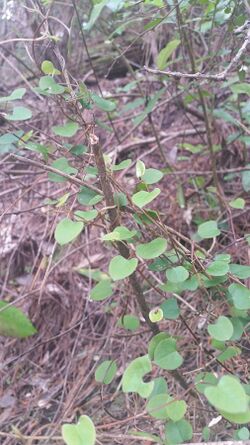Biology:Muehlenbeckia australis
| Muehlenbeckia australis | |
|---|---|

| |
| Scientific classification | |
| Kingdom: | Plantae |
| Clade: | Tracheophytes |
| Clade: | Angiosperms |
| Clade: | Eudicots |
| Order: | Caryophyllales |
| Family: | Polygonaceae |
| Genus: | Muehlenbeckia |
| Species: | M. australis
|
| Binomial name | |
| Muehlenbeckia australis (G.Forst.) Meisn.
| |
| Synonyms[1] | |
| |
Muehlenbeckia australis, the large-leaved muehlenbeckia or pohuehue, is a prostrate or climbing plant native to New Zealand.[2]
Description
The species grows up to 10 metres (33 ft) tall with grey bark. The leaves are on stiff petioles and are 25 millimetres (0.98 in) long. Lamina is 2–8 centimetres (0.79–3.15 in) by 1–3 centimetres (0.39–1.18 in) long.[1] It has juvenile and adult leaf forms and loses its leaves in winter. The flowers are greenish and the fruits are juicy with black shiny seeds covered by a white, succulent cup of sepals, which are fed on by various birds and lizards.[2] Flowers bloom from late spring to autumn, with it panicles occur usually in spring and summer.[2] Fruits are present from November to April, sometimes till June.[1]
Taxonomy
The species was first described in 1786 by Georg Forster, as Coccoloba australis. It was transferred to the genus Muehlenbeckia in 1841 by Carl Meissner.[3] Some sources, including Plants of the World Online, regard Muehlenbeckia adpressa as a synonym of this species.[4] Others treat them as separate species.[5]
Ecology
M. australis prefers places with plenty of sunlight and climbing support, such as forest edges, cliff faces, scrub and regenerating vegetation. With its climbing and rapid growth form, it is capable of engulfing roadside trees, and has benefited from cleared habitats created since human settlement began, and is sometimes the only native species present in such areas.[2]
Host plant
M. australis is a host plant for numerous New Zealand endemic insects including Pyrgotis eudorana, Apoctena orthropis, Argosarchus horridus, and Clitarchus hookeri.[6][7]
References
- ↑ 1.0 1.1 1.2 "Muehlenbeckia australis". New Zealand Flora. http://www.nzflora.info/factsheet/Taxon/Muehlenbeckia_australis.html.
- ↑ 2.0 2.1 2.2 2.3 "Muehlenbeckia australis (Pohuehue)". T.E.R:R.A.I.N. http://www.terrain.net.nz/friends-of-te-henui-group/new-plant-page/muehlenbeckia.html.
- ↑ "Plant Name Details for Muehlenbeckia australis (G.Forst.) Meisn.". The International Plant Names Index. http://www.ipni.org/ipni/idPlantNameSearch.do?id=694738-1.
- ↑ "Muehlenbeckia adpressa (Labill.) Meisn.", Plants of the World Online (Royal Botanic Gardens, Kew), https://powo.science.kew.org/taxon/urn:lsid:ipni.org:names:694735-1, retrieved 2019-03-06
- ↑ "Vascular Plants: Muehlenbeckia adpressa". Australian Plant Name Index (APNI). https://biodiversity.org.au/nsl/services/apni?name=MUEHLENBECKIA+ADPRESSA.
- ↑ Dugdale, J. S. (1971). "Entomology of the Aucklands and other islands South of New Zealand: lepidoptera, excluding non-Crambine Pyralidae". Pacific Insects Monograph 27: 72. http://hbs.bishopmuseum.org/pim/pdf/pim27-55.pdf. Retrieved 16 January 2017.
- ↑ "Muehlenbeckia australis (G.Forst.) Meisn.". 2022. https://plant-synz.landcareresearch.co.nz/ReportForm.aspx?RecordId=253&Type=P&ReportType=Adv&SortBy=Alpha&Biostatus=a,c,e,n.
External links
Wikidata ☰ Q15600466 entry
 |

